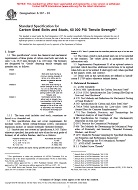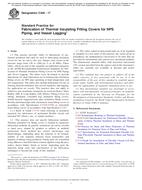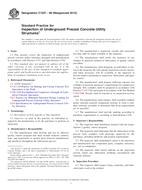Click here to purchase
DESIG: E 2281 08a ^TITLE: Standard Practice for Process and Measurement Capability Indices ^SIGNUSE:
Process Capability – Process capability can be defined as the natural or inherent behavior of a stable process that is in a state of statistical control (1). A “state of statistical control“ is achieved when the process exhibits no detectable patterns or trends, such that the variation seen in the data is believed to be random and inherent to the process. Process capability is linked to the use of control charts and the state of statistical control. A process must be studied to evaluate its state of control before evaluating process capability.
Process Control – There are many ways to implement control charts, but the most popular choice is to achieve a state of statistical control for the process under study. Special causes are identified by a set of rules based on probability theory. The process is investigated whenever the chart signals the occurrence of special causes. Taking appropriate actions to eliminate identified special causes and preventing their reappearance will ultimately obtain a state of statistical control. In this state, a minimum level of variation may be reached, which is referred to as common cause or inherent variation. For the purpose of this standard, this variation is a measure of the uniformity of process output, typically a product characteristic.
Process Capability Indices – The behavior of a process (as related to inherent variability) in the state of statistical control is used to describe its capability. To compare a process with customer requirements (or specifications), it is common practice to think of capability in terms of the proportion of the process output that is within product specifications or tolerances. The metric of this proportion is the percentage of the process spread used up by the specification. This comparison becomes the essence of all process capability measures. The manner in which these measures are calculated defines the different types of capability indices and their use. Two process capability indices are defined in 5.2 and 5.3. In practice, these indices are used to drive process improvement through continuous improvement efforts. These indices may be used to identify the need for management actions required to reduce common cause variation, compare products from different sources, and to compare processes.
Process Performance Indices – When a process is not in a state of statistical control, the process is subject to special cause variation, which can manifest itself in various ways on the process variability. Special causes can give rise to changes in the short-term variability of the process or can cause long-term shifts or drifts of the process mean. Special causes can also create transient shifts or spikes in the process mean. Even in such cases, there may be a need to assess the long-term variability of the process against customer specifications using process performance indices, which are defined in 6.2 and 6.3. These indices are similar to those for capability indices and differ only in the estimate of variability used in the calculation. This estimated variability includes additional components of variation due to special causes. Since process performance indices have additional components of variation, process performance usually has a wider spread than the process capability spread. These measures are useful in determining the role of measurement and sampling variability when compared to product uniformity.
^SCOPE:
1.1 This practice provides guidance for the use of capability indices for evaluating process capability and performance. Process capability indices compare the variability of a process quality measure against product specifications or tolerances and assume the process is in a state of statistical control. Process performance indices are useful in situations when the process is not in a state of statistical control.
^REFERENCE:
ASTM Standards:
E 456 Terminology Relating to Quality and Statistics
E 2586 Practice for Calculating and Using Basic Statistics
ISO Standard:
ISO 3534-2 Statistics–Vocabulary and Symbols-Statistical Quality Control
Other Document:
MNL 7 Manual on Presentation of Data and Control Chart Analysis
^KEYWORDS: long-term variability; process capability; process capability indices; process performance; process performance indices; short-term variability ^INDEX TERMS: Capability indices; Long-term variability; Observation/observed values; Performance–laboratory instrumentation/process; Precision–test methods; Process capability/performance indices (C
Product Details
- Published:
- 10/01/2008
- Number of Pages:
- 8
- File Size:
- 1 file , 100 KB
- Redline File Size:
- 2 files , 200 KB


